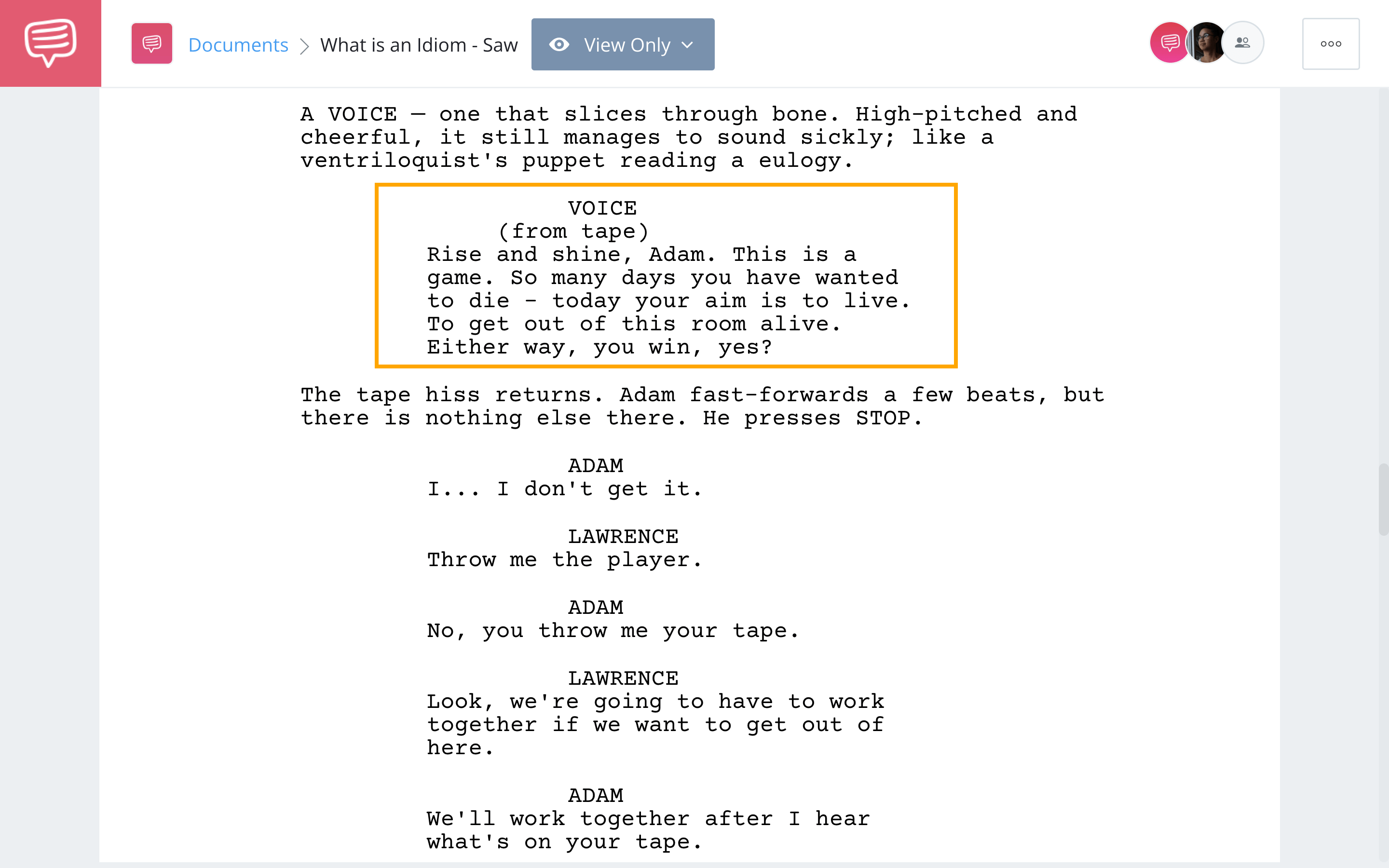Have you ever heard an expression but had no idea what it meant? If you have, it’s probably because it was an idiom. Writers are always looking for the most natural way to write dialogue and literary devices like the idiom are just one technique available. But what is an idiom? We’re going to answer that question by breaking down the idiom definition and by looking at some examples.
Define Idiom
First, let’s define idiom
What is an idiom? A more general answer is that it is a literary device writers use to capture "realistic dialogue." A more specific answer is that it the use of expressions and turns of phrase to communicate. Let’s answer that question with an idiom definition.
IDIOM DEFINITION
What is an idiom?
An idiom is a figurative expression where the meaning cannot be interpreted solely by the conjunction of its words; e.g., “by the skin of your teeth” means “barely getting by.” These expressions and phrases are interpreted as nonsensical by those who don’t have prior knowledge of them. They are also often culturally specific — most languages and cultures have their own sets. This form of expression is often confused with other literary devices such as metaphor, simile, proverbs, euphemisms and cliches. But as we will explain in a minute, there are distinct differences in form and function.
Idiom Examples:
- Beat around the bush
- Under the weather
- The last straw
- Miss the boat
Idioms can often be confused with other types of figurative language. Let’s take a look at what makes them distinct.
Origins
What is an idiom (and what isn’t)
Idioms fall under the umbrella of figurative language, which plays an important role in writing and everyday conversations.
But what is figurative language?
Figurative language is when something means something other than its literal meaning. For example: the term “I feel like a million bucks” is an example of figurative language.
Metaphors, similes, and allusions are all types of figurative language.
We use idioms to communicate non-literal ideas, but we also use other figurative language to do the same thing. So, what makes them different?
Idiom vs. Metaphor
A metaphor is when a word is applied to another word in a non-literal manner. For example: “Jeff was a rollercoaster.” Jeff is not literally a rollercoaster, he just is temperamental. But we can derive meaning from this phrase even if we haven’t heard it before.
With an phrase like “pulling someone’s leg,” you’re not applying a word to another word figuratively; the entire phrase is figurative. That said, sometimes an idiom can be a metaphor (and vice versa).
Take, for example, “it’s not rocket science.” This is a common idiom, but also is comparing two things figuratively– “rocket science” and “it.”
Idiom vs. Proverb
Idioms and proverbs are also commonly confused. Like an idiom, proverbs are widely repeated. But with proverbs, meaning can be derived from the phrase even without prior knowledge. Take the proverb “a picture is worth a thousand words.” If you had never heard this phrase before, you would still be able to discern its message: pictures can contain a lot of information.
If you had never heard the expression “bite the bullet,” you’d be a little lost.
Idiom vs. Euphemism
A euphemism uses an indirect word to convey a harsher meaning, like saying “I’m in between jobs” instead of “I’m unemployed.” Idioms can sometimes operate as euphemisms, like saying “she has a bun in the oven” instead of “she’s pregnant.”
But not all euphemisms are idioms, and not all idioms are euphemisms. “I’m in between jobs” conveys a clear meaning, even if it sounds nicer than “I’m unemployed,” so it isn’t an idiom. Likewise, “let’s bite the bullet” isn’t really a softer way to say “let’s get it done,” so it’s not a euphemism.
Idiom vs. Cliché
A cliché is often in the eye of the beholder. The term refers to a phrase or idea that is overused. So, by definition, most idioms are clichés, since they depend on wide usage to convey their meaning. If “hit the sack” wasn’t said by everybody, nobody would know what it meant.
So most idioms could be considered clichés, but not all clichés are idioms. Take “cold as ice.” Anyone without prior knowledge understands what that means, so it’s not an idiom, but it’s an overused phrase, so you could call it a cliché.
Storytelling Idioms
Types of Idioms
Now that we’ve compared this device to other types of figurative language, let’s look at the various types of idioms. We know, we know — a lot of categorizing.
Pure
The pure idiom is the most easily recognizable form, the one we’ve been using the most so far. It’s a full phrase which has a meaning that can’t be deduced without prior knowledge.
Some more pure idiom examples: “speak of the devil,” “let her off the hook.”
Binomial
The binomial idiom is short and sweet. Wait a minute – that was one right there. The binomial is two words combined with a conjunction. Like with all idioms, the meaning is unclear to anyone who hasn’t heard it before.
With “short and sweet,” it may not be obvious what exactly the sweet part might mean.
Here are some additional binomial idiom examples: “by and large,” “bread and butter,” “fair and square,” “heart to heart.”
Partial
A partial idiom is, as its name may indicate, just a part of an idiom. The most common example of this is “when in Rome.” The entire idiom is “when in Rome, do as the Romans do.”
More than any other type, partial idioms really rely on familiarity.
Prepositional
Last but not least, we have prepositional idioms. These are phrases which combine a preposition and a word to alter the meaning of said word.
They’re pretty subtle – think of “in advance,” “on hand,” or “out of the blue,” for example.
Classic Expressions
Idiom Examples
Different languages and different dialects have their own particular idiom examples. Here are some common idiom examples in English:
- “It’s raining cats and dogs out there.” – there is a lot of rain outside
- “Things are getting out of hand.” – losing control over a situation
- “Going to hit the sack.” – going to sleep
- “Missed the boat.” – too late
- “Feeling under the weather.” – feeling sick
- “Play devil’s advocate.” – take a contrarian stance
- “Kill two birds with one stone.” – accomplish two tasks with one action
- “Break the ice.” – open a line of communication
- “Don’t count your chickens before they hatch.” – don’t assume something is going to happen
- “Spill the beans.” – share a secret
- “Don’t judge a book by its cover.” – don’t judge something by what it appears to be
- “Elephant in the room.” – an unspoken but known issue
These are just some of the most common idiom examples in English – you might be surprised just how many there are! If you want to check out some other idiom examples (along with some great animations), check out the video from Domics below.
Idioms are niche examples of figurative language – but they play an important role in cultural learning. Let’s look at how these expressions are used by analyzing why they’re an important part of cultural learning.
Idiom Meaning
Why use idioms?
We use idioms in everyday conversations – but what are the benefits of including them in writing? Well, they add linguistic nuance to conversation and tell us about the culture of characters.
Every language has its own idioms. They are developed over time to express peculiarities about cultures, and oftentimes, they’re nonsensical when translated literally.
Why is that? Because they’re a sort of cultural “inside joke.”
Take this example from Saw, which was written by Leigh Whannell and James Wan. We imported the script into StudioBinder’s screenwriting software:
Saw Idiom Example • Read Full Scene
Here, the “voice” uses a binomial idiom: “rise and shine.” By using this friendly and colloquial term, Whannell and Wan make the scene much creepier. There’s nothing worse than faux-friendliness from a sadistic monster.
On a lighter note, I like to reference this example when explaining the difference between idioms in different cultures:
In Italian, people often say “in bocca al lupo” to wish good luck. “In bocca al lupo” translates to English as “in the mouth of the wolf.” Wait, that doesn’t make sense! Well, figuratively it kind of does.
In English, people often say “break a leg” to wish good luck. When you think about it, neither “break a leg” or “in the mouth of the wolf” have anything to do with wishing good luck. This underscores the greater notion that cultures often express ideas differently while retaining the same connotation.
Essentially, an idiom may have the same meaning as others, even if they seemingly make no sense.
By using idioms in writing, we can build universality (or even confusion). Idioms are simply tools for writers to experiment with.
What does this video teach us about idioms? Well, I’d say it teaches us that these expressions are part of “universal language.” Although we use different words, we often express the same things. In other words, the notion of “good luck” is part of universal language – and although we wish good luck in different ways, we mean the same thing.
By using idioms in writing, we can build universality (or even confusion). Idioms are simply tools for writers to experiment with.
UP NEXT
What are Tropes?
Tropes are an important part of figurative storytelling – but what are tropes? In our next article, we’ll explain tropes with examples from Once Upon a Time… in Hollywood, The Other Guys, and more. We’ll also show you can use tropes subversively to avoid creating cliches.

